In/Spectre
January 31, 2022 · 0 comments
By Andrew Osmond.
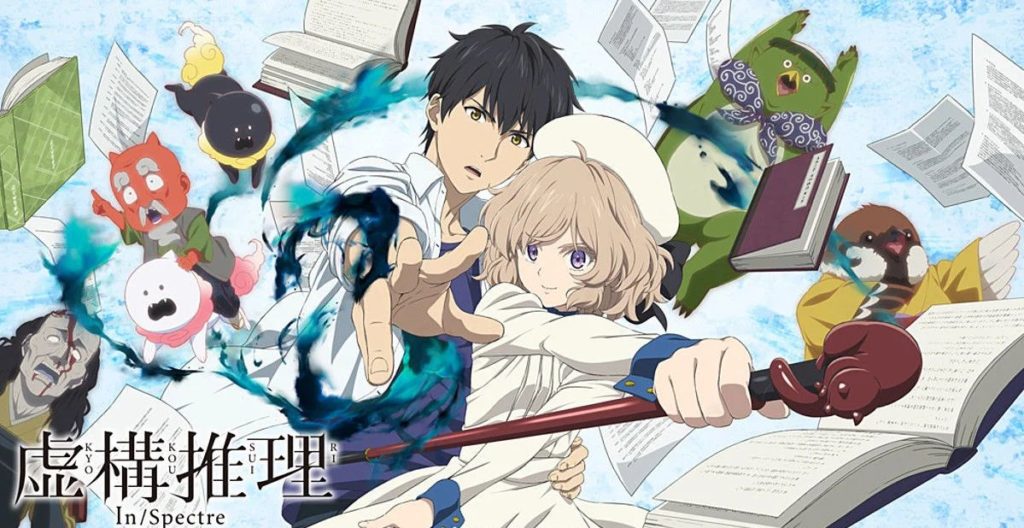
Watching the series In/Spectre may put you in mind of one of the most prominent displays at the huge manga exhibition mounted at the British Museum in 2019. It was a massive curtain from a kabuki theatre, 17 metres long, created back in 1880. The curtain showed the kabuki stars of the day as giant-sized ghosts and goblins, looming and leering over the audience, and it anticipates the two sides of In/Spectre.
On the one hand, this is a yokai show like many other anime, full of strange creatures from the spirit world, and featuring two human leads who can see into that world. On the other, In/spectre is a complex and metatextual series about what yokai mean to us mortals, how we create them, tell tales about them, and give them life through our imaginations.
Like many anime, In/spectre starts with boy meeting girl. The boy is Kuro, a rather glum-looking youth who’s recently broken up with his girlfriend. He’s sitting on a bench when another girl approaches him boldly, with none of the shyness of most anime females. She’s called Kotoko Iwanaga; even with her intimate acquaintances, she prefers to be called by her family name, which has the characters for “rock” and “eternity.” With her petite frame, ornate staff and flouncy skirt, Iwanaga resembles a traditional magic girl heroine, though she informs Kuro that she’s seventeen, almost as old as he is.
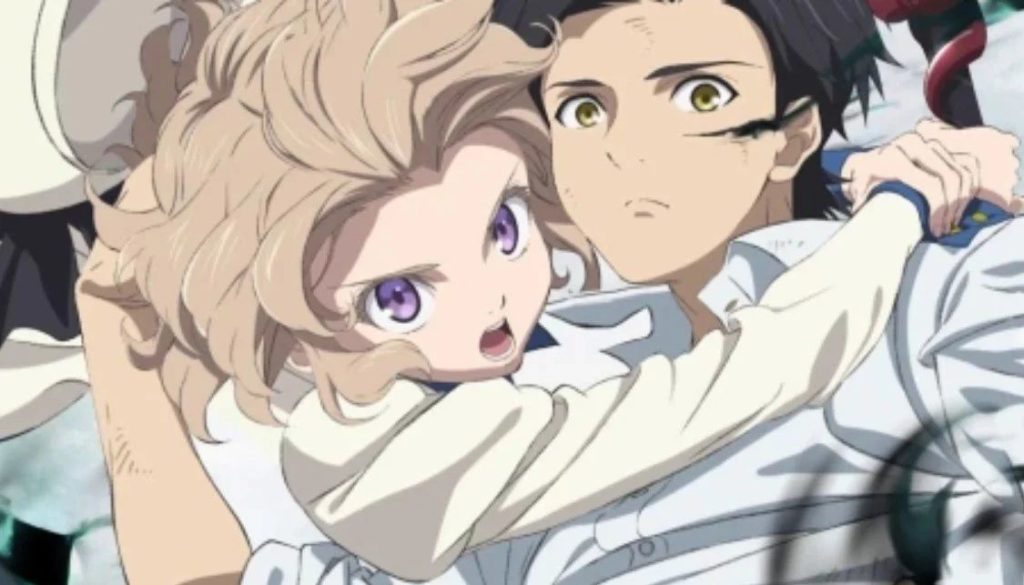
Iwanaga tells Kuro that she’s been in unrequited love with him for the last two years, ever since they briefly bumped into each other at hospital, an incident Kuro has forgotten. Iwanaga was in hospital because of her prosthetics; one of her eyes and one of her legs are artificial. That’s because when she was little, Iwanaga was spirited away by yokai; rather cute little yokai, actually, who asked her to become their goddess of wisdom. Iwanaga agreed, and wound up back in her own world minus one eye and one leg, but with no pain or trauma. In return, she can see spirits everywhere, who regularly beseech her for help, especially when something comes along to scare them.
Something like Kuro, for instance. For Iwanaga knows Kuro isn’t a normal boy either; there’s something about him that sends even demons running. Again, it’s something that happened when Kuro was a child, but not something innocent like being spirited away. Rather, Kuro has eaten yokai flesh – shades of Rumiko Takahashi’s dark manga Mermaid’s Scar – giving him two remarkable attributes. He can recover from any injury, including fatal ones; and he has the power to see the future. When we eventually learn Kuro’s full backstory, it’s unbelievably dark; it echoes the horrors committed in the name of science, especially in wartime.
Kuro’s powers sound like the set-up for an action series, and he’s often in bloody fights with monsters. But In/spectre isn’t really an actioner; it’s more of a romcom, and a puzzle show. The comedy is mainly between Kuro and Iwanaga, who are quickly established as an extremely odd couple. Iwanaga is outrageously demanding and terrifyingly frank, though you’re often left wondering if she’s telling the truth. Kuro seems utterly passive and non-confrontational; Iwanaga compares him to a goat chewing grass all day. As reviewer Theron Martin pointed out on Anime News Network, this refers to a common Japanese stereotype of the “herbivore” male who lacks any drive or ambition. But, Iwanaga reflects, even goats possess a vitality, and they can have horns like demons…

As for the puzzle aspect of the series, that becomes clear in part two of the series, after Kuro and Iwanaga have become acquainted. As part of her duties as Goddess of Wisdom, Iwanaga visits a swamp in the deep mountains, where dwells a giant snake spirit. This spirit used to be worshipped as a water god, although she reflects sadly that no-one has tended her overgrown shrine for many years. Viewers may be reminded of Miyazaki’s Spirited Away, about spirits who were similarly forgotten.
The serpent has called on Iwanaga because she’s perplexed by an incident at her swamp. A woman came to the remote place, bringing the body of a murdered man – actually, the woman has already confessed she killed him to police. The really odd thing, though, is what the snake heard the woman say as she tipped the corpse in: “I hope they find you.” What on earth did she mean by that, and can Iwanaga shed light on it?
Without moving from the spot, Iwanaga starts to cover what’s known about the mystery – for example, that the murdered man worked with the woman’s boyfriend, and may have been responsible for his murder. Suddenly we’re in a different genre, the mystery series. Mystery stories are hugely popular in Japan, and have been for more than a century, whether imported authors like Britain’s Agatha Christie and Sir Arthur Conan Doyle, or Japanese masters like Edogawa Ranpo (real name Taro Hirai).
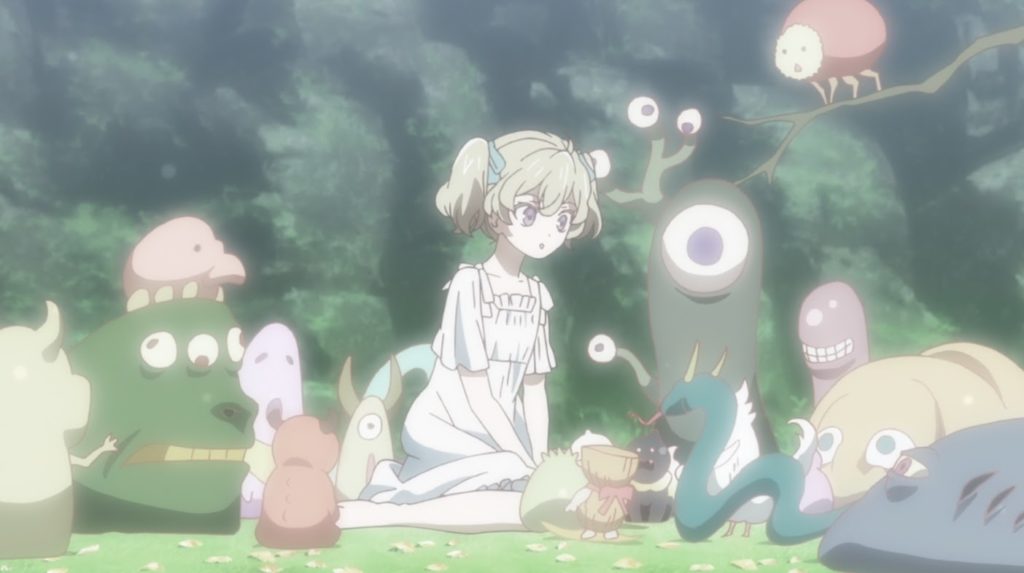
The approach that’s used in In/Spectre – of Iwanaga talking through a puzzle methodically, letting the speculations go where they will – feels akin to a Kyoto Animation series, Hyouka, about school-aged detectives. That wasn’t a fantasy series, but you might also think of Rokka: Braves of the Six Flowers. It started as a fantasy quest epic and then transformed midway through into a huge whodunnit as the show’s heroes learned they had a traitor in their midst.
But In/Spectre has an extra, subversive twist. It very deliberately blurs the boundaries between deduction and invention, between finding the answer to a puzzle and inventing an answer to a puzzle. In doing so, the series investigates why we love mystery stories. It’s both because they have meaty puzzles for us to try to solve ahead of the narrative, but also because they have good stories, with resonances and morals and shock twists.
During the snake story, we’re reminded that Iwanaga has sources of information beyond a conventional detective; she can use ghosts to find things out! That might seem utterly bizarre for a mystery story, but it’s not without precedent. In the classic Rashomon story, as filmed by Akira Kurosawa, a crime is being investigated and one of the “witnesses” who’s called up to testify is a ghost speaking through a medium. But beyond such special sources, Iwanaga blithely admits to Kuro that she’s going beyond any watertight deductions.
Rather, she’s constructing a captivating story that will satisfy the snake spirit. She’s like the kind of a mystery author who hides leaps in logic behind the addictiveness of her plot. And this approach will drive the main story in the In/Spectre, one that has strong resonances today, about a phantom pop idol on a bloody hunt for vengeance….
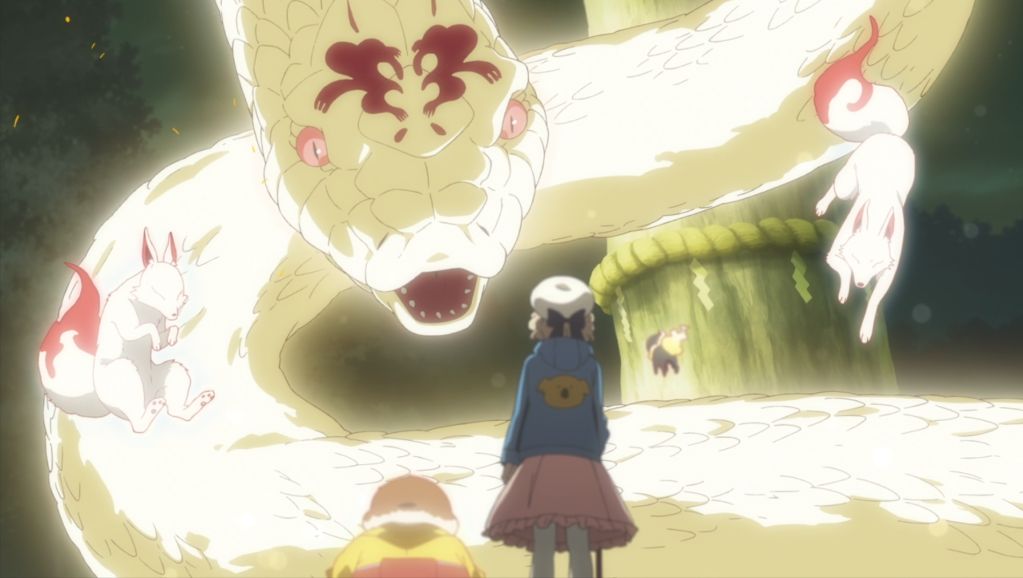
While In/Spectre is set in modern Japan, its first episodes highlight old-fashioned elements; yokai creatures from centuries-old stories, and tales of children being spirited away. However, the main storyline brings in much more contemporary elements: idol singers, press scandals, and the reality-bending impact of today’s great myth generator, the Internet.
This storyline involves Iwanaga – initially without Kuro, who’s gone missing – investigating a spectre haunting a city. This giant-sized ghost is called Steel Lady Nanase, and she’s dressed as an idol singer. Her bosom is big enough to be a meme in itself. She has no face, and she wields a huge iron bar. She’s said to be the ghost of a recently-deceased singer called Nanase Kirin, who died in a freak accident, crushed by a similar beam on a building site at the dead of night.
While Iwanaga may be without Kuro at first, she runs into someone else – Kuro’s ex-girlfriend Saki, who’s now working as a policewoman. Naturally there’s some love-triangle comedy, as Saki tries to comprehend how on earth Kuro and Iwanaga could be a couple. For one thing, Saki’s sure that the petite Iwanaga is absolutely not Kuro’s type. There’s a joke in the girls’ names – Iwanaga and Saki are both named after sisters in a story in one of Japan’s most ancient texts, the Kojiki. As the reference gets explained in the anime, I won’t give it away here, but it suggests which girl might be the right partner for the undying Kuro.
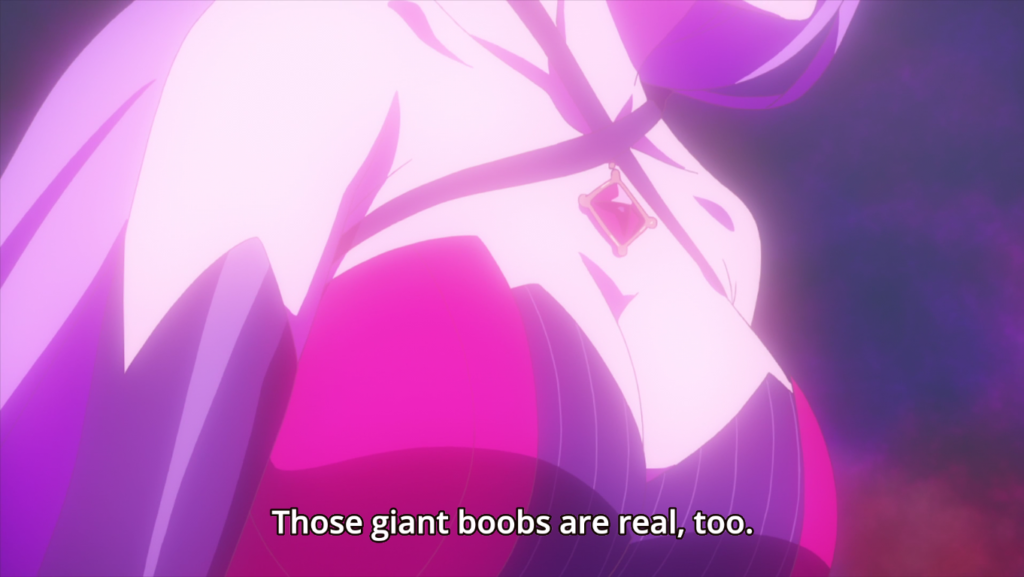
Steel Lady Nanase, on the other hand, is an avowedly modern myth. The image of the phantom pop singer inevitably evokes the film Perfect Blue, as do some of the story’s themes. As in that film, the real “monster” is the internet, the aggregated animus of millions of people, which plays a major role in the later episodes. It’s a contrast to Mamoru Hosoda films like Summer Wars and Belle, which present hopeful visions of the internet where decency and kindness spread through the crowd. In In/Spectre, the Internet is amoral at best, and only useful as a tool to manipulate – to Iwanaga, but to other parties as well.
The Nanase storyline culminates in a plethora of faked flashbacks and contradicting stories, a Rashomon for cyberspace. Some of these stories involve “explaining away” the supernatural as a magic trick. You might think that would make for a disappointing story, but remember it’s the basis for one of the most famous mystery stories ever, the Sherlock Holmes adventure The Hound of the Baskervilles. The jumble of narratives and theories may also remind you of the pseudo-historical literature around Jack the Ripper, with its supporting cast of Freemasons, Royal scandals and so on.
The source novels for In/Spectre were published in the 2010s, written by Kyo Shiroida. However, by the time the anime was broadcast in 2020, the Nanase storyline was looking scarily on the money. There are references to the idol singer Nanase battling with a father who was living off her; the anime came out just months before “FreeBritney” trended on Twitter. As for In/Spectre’s depiction of the power of Internet “investigations,” generating snowballing secret histories and whole alternate realities for believers… Well, you’ve probably heard of QAnon.
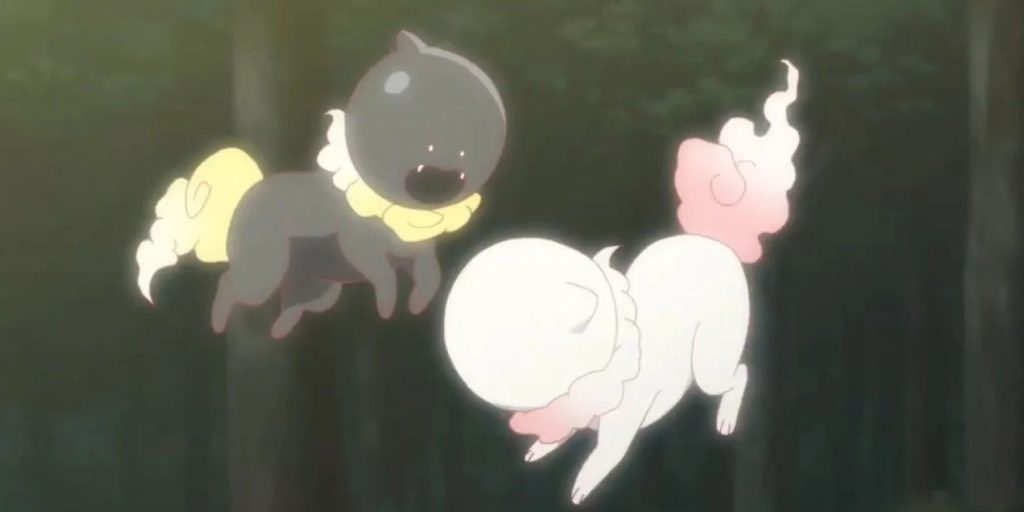
Orchestrating these rumours, Iwanaga plays the part of a great detective, though she’s more a great manipulator, or simply a great storyteller. Interviewed by Crunchyroll, the producer Tatsuya Ishiguro explained, “With (Iwanaga), since this is a mystery series, she generally has very, very long lines, and she talks a lot. She needs a very serious tone, but also she’s able to flip really quickly and have a cutesy tone, and Akari Kito [Iwanaga’s Japanese voice actor] did that really well.”
The anime is very dialogue-heavy, even though it was primarily based not on the original Shiroida novel, but on a manga version which began in 2015. By 2017, it was reported that the manga had one and a half million copies in print. “Despite it being a manga, there’s a lot of dialogue and a lot of words,” said Ishiguro. “The staff at first was very worried that they weren’t going to be able to fit all the dialogue in a 30-minute episode.”
“When we adapt something from an original story,” Ishiguro continues, “usually we can add padding or take stuff off that we don’t feel fits. But for this series, it was extremely hard to cut anything out. So again, we have to drop some stuff, so we’ve been very carefully cherry-picking the absolute best things we can.”
As Ishiguro mentioned, the lion’s share of the script was given to Iwanaga’s actor Akari Kito. However, she has the very different Kuto to play off, who’s voiced by one of the most familiar male voice-actors in anime. It’s Mamoru Miyano, who voiced Light Yagami in Death Note. You may also know Miyano as – to name a few – Kiba in Wolf’s Rain, Setsuna in Gundam 00, Rintaro in Steins;Gate, Rin in the Free! franchise, Kei in Ajin: Demi-Human and Kotaro in Zombie Land Saga.
“In the series, Kotoko describes Kuro as a goat, or compares him to a goat,” Ishiguro told Crunchyroll, “and Miyano Mamoru has a very soft, kind-sounding voice. But also there’s something lingering in the background that’s sort or strange and unique, so it’s perfect.”
Andrew Osmond is the author of 100 Animated Feature Films. In/Spectre is released in the UK by Anime Limited.
Leave a Reply